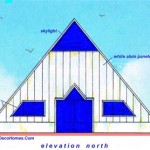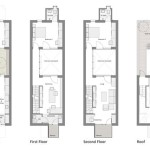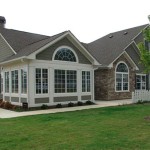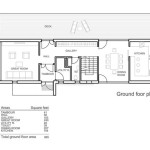House plans with vaulted ceilings incorporate ceilings that extend upward to the roofline, creating a sense of spaciousness and grandeur. They often feature tall windows or skylights that allow for abundant natural light, further enhancing the airy and inviting atmosphere.
Vaulted ceilings offer both aesthetic and functional benefits. They can make a small room appear larger and more open, and they provide ample vertical space for architectural features such as beams, chandeliers, and artwork. In addition, the increased air volume created by vaulted ceilings can improve ventilation and reduce energy costs by allowing warm air to rise and cool air to circulate.
Whether you’re planning to build a new home or remodel your existing one, a house plan with vaulted ceilings can be a transformative choice. In the following sections, we’ll explore the different types of vaulted ceilings, their design considerations, and the benefits and drawbacks of incorporating them into your home’s design.
Here are 9 important points about house plans with vaulted ceilings:
- Create a sense of space and grandeur
- Allow for abundant natural light
- Enhance ventilation and reduce energy costs
- Can make a small room appear larger
- Provide ample vertical space for architectural features
- Can be more expensive to build than traditional ceilings
- May require additional structural support
- Can be difficult to heat and cool
- May not be suitable for all architectural styles
When considering a house plan with vaulted ceilings, it is important to weigh the benefits and drawbacks carefully to determine if this type of design is right for you and your home.
Create a sense of space and grandeur
One of the most striking features of house plans with vaulted ceilings is their ability to create a sense of space and grandeur. By eliminating the horizontal barrier of a traditional flat ceiling, vaulted ceilings draw the eye upward and make a room feel larger and more open. This effect is particularly pronounced in rooms with high ceilings, where the vertical space can be truly breathtaking.
In addition to making a room feel larger, vaulted ceilings can also create a sense of grandeur. The upward sweep of the ceiling creates a focal point that draws the eye and adds a touch of drama to any space. This makes vaulted ceilings ideal for rooms that are used for entertaining or special occasions, such as living rooms, dining rooms, and entryways.
Another benefit of vaulted ceilings is that they can make a small room appear larger. By eliminating the visual clutter of a traditional ceiling, vaulted ceilings create a more open and airy feel. This can be especially beneficial in small rooms, where every square foot counts. In addition, vaulted ceilings can help to make a room feel brighter and more inviting by allowing for more natural light to enter the space.
Overall, vaulted ceilings can be a transformative design element that can add a sense of space, grandeur, and brightness to any room. Whether you’re planning to build a new home or remodel your existing one, vaulted ceilings are a design option that is worth considering.
Allow for abundant natural light
One of the most significant benefits of house plans with vaulted ceilings is that they allow for abundant natural light. By eliminating the horizontal barrier of a traditional flat ceiling, vaulted ceilings create a more open and airy feel, and they allow for more windows and skylights to be installed.
Natural light has many benefits for both our physical and mental health. It can help to improve our mood, boost our energy levels, and increase our productivity. In addition, natural light can help to reduce our risk of developing certain health conditions, such as SAD (Seasonal Affective Disorder) and vitamin D deficiency.
In a home with vaulted ceilings, the increased amount of natural light can make a significant difference in the overall ambiance of the space. Rooms with vaulted ceilings feel brighter, more inviting, and more connected to the outdoors. This can be especially beneficial in areas of the home where we spend a lot of time, such as the living room, kitchen, and dining room.
In addition to the benefits for our health and well-being, natural light can also help to reduce our energy costs. By using natural light to illuminate our homes, we can reduce our reliance on artificial lighting, which can save us money on our energy bills.
Overall, the ability of house plans with vaulted ceilings to allow for abundant natural light is a major benefit that can improve our quality of life and save us money on our energy bills.
Enhance ventilation and reduce energy costs
Another significant benefit of house plans with vaulted ceilings is that they can enhance ventilation and reduce energy costs. Vaulted ceilings create a larger volume of air within a room, which allows for better air circulation and ventilation. This can help to improve the indoor air quality and reduce the risk of moisture and mold problems.
In addition, the increased air volume created by vaulted ceilings can help to reduce energy costs by allowing warm air to rise and cool air to circulate. This natural convection can help to reduce the need for heating and cooling systems to work as hard, which can save you money on your energy bills.
There are a few things you can do to further enhance the ventilation and energy efficiency of your home with vaulted ceilings. First, be sure to install plenty of windows and skylights to allow for natural light and ventilation. Second, consider installing ceiling fans to help circulate the air. Finally, be sure to seal any air leaks around windows, doors, and other openings to prevent drafts.
Overall, house plans with vaulted ceilings offer a number of benefits related to ventilation and energy efficiency. By creating a larger volume of air within a room, vaulted ceilings can help to improve air circulation, reduce moisture and mold problems, and reduce energy costs.
Paragraph after details
In addition to the benefits mentioned above, vaulted ceilings can also help to reduce noise levels within a room. The increased volume of air created by vaulted ceilings helps to absorb sound waves, which can make a room feel quieter and more peaceful.
Can make a small room appear larger
One of the most significant benefits of house plans with vaulted ceilings is their ability to make a small room appear larger. By eliminating the horizontal barrier of a traditional flat ceiling, vaulted ceilings create a more open and airy feel, which can make a small room feel more spacious and inviting.
In addition to making a room feel larger, vaulted ceilings can also make a room feel brighter and more welcoming. The increased height of the ceiling allows for more natural light to enter the space, which can make a small room feel more open and less cramped. In addition, the upward sweep of the ceiling creates a focal point that draws the eye upward, which can help to make a small room feel more visually interesting.
Another benefit of vaulted ceilings in small rooms is that they can help to create a sense of vertical space. This can be especially beneficial in rooms with low ceilings, where the lack of vertical space can make a room feel cramped and confining. By adding a vaulted ceiling, you can create the illusion of more space and make a small room feel more open and airy.
Overall, vaulted ceilings can be a great way to make a small room appear larger and more inviting. By creating a more open and airy feel, vaulted ceilings can help to make a small room feel more spacious, brighter, and more visually interesting.
However, it is important to note that vaulted ceilings are not always the best choice for small rooms. In some cases, a vaulted ceiling can make a small room feel even smaller and more cramped. This is especially true if the vaulted ceiling is too high or if the room is not properly furnished.
When considering a vaulted ceiling for a small room, it is important to carefully consider the size of the room and the overall design of the space. If you are not sure whether a vaulted ceiling is right for your small room, it is always a good idea to consult with a qualified architect or designer.
Provide ample vertical space for architectural features
Another benefit of house plans with vaulted ceilings is that they provide ample vertical space for architectural features. The increased height of the ceiling allows for the installation of dramatic features such as beams, chandeliers, and artwork.
- Beams
Exposed beams can add a touch of rustic charm to a vaulted ceiling. They can also be used to create a focal point or to divide a large space into smaller areas. Beams can be made from a variety of materials, including wood, metal, and concrete.
- Chandeliers
A chandelier is a type of light fixture that is suspended from the ceiling. Chandeliers can add a touch of elegance and grandeur to a vaulted ceiling. They are available in a wide range of styles, from traditional to modern.
- Artwork
A large piece of artwork can make a stunning statement on a vaulted ceiling. Artwork can be hung from the ceiling or mounted on the wall. When choosing artwork for a vaulted ceiling, be sure to select a piece that is large enough to fill the space and that complements the overall design of the room.
- Other architectural features
In addition to beams, chandeliers, and artwork, there are a number of other architectural features that can be used to enhance the look of a vaulted ceiling. These features include:
- Moldings
- Cornices
- Medallions
- Skylights
With so many options to choose from, you can create a vaulted ceiling that is both beautiful and unique.
Can be more expensive to build than traditional ceilings
One of the potential drawbacks of house plans with vaulted ceilings is that they can be more expensive to build than traditional ceilings. This is because vaulted ceilings require more materials and labor to construct. In addition, vaulted ceilings may require additional structural support, which can further increase the cost.
- Materials
Vaulted ceilings require more materials to construct than traditional ceilings. This is because vaulted ceilings have a larger surface area, and they often require additional framing and support. The cost of materials for a vaulted ceiling will vary depending on the size and complexity of the ceiling, as well as the materials used.
- Labor
Vaulted ceilings also require more labor to construct than traditional ceilings. This is because vaulted ceilings are more difficult to frame and install. In addition, vaulted ceilings may require additional structural support, which can further increase the labor costs.
- Structural support
In some cases, vaulted ceilings may require additional structural support. This is especially true for vaulted ceilings that are large or complex. The cost of structural support will vary depending on the size and complexity of the ceiling, as well as the materials used.
- Other costs
In addition to the materials, labor, and structural support costs, there may be other costs associated with building a vaulted ceiling. These costs may include the cost of permits, inspections, and engineering fees.
Overall, the cost of building a vaulted ceiling will vary depending on a number of factors, including the size and complexity of the ceiling, the materials used, and the labor costs in your area. It is important to factor in all of these costs when budgeting for a vaulted ceiling.
May require additional structural support
In some cases, vaulted ceilings may require additional structural support. This is especially true for vaulted ceilings that are large or complex. The type of structural support required will vary depending on the size and complexity of the ceiling, as well as the materials used.
One common type of structural support for vaulted ceilings is a truss. A truss is a pre-engineered structural frame that is designed to support a specific load. Trusses are typically made from wood or metal, and they are available in a variety of sizes and shapes. Trusses can be used to support the entire span of a vaulted ceiling, or they can be used to support specific sections of the ceiling, such as the ridge beam or the purlins.
Another type of structural support for vaulted ceilings is a beam. A beam is a horizontal structural member that is used to support a load. Beams can be made from a variety of materials, including wood, steel, and concrete. Beams are typically used to support the ridge beam of a vaulted ceiling, or they can be used to support the purlins.
In some cases, a vaulted ceiling may require both trusses and beams. This is typically the case for large or complex vaulted ceilings. Trusses and beams work together to provide the necessary structural support for the ceiling.
The cost of structural support for a vaulted ceiling will vary depending on the size and complexity of the ceiling, as well as the materials used. It is important to factor in the cost of structural support when budgeting for a vaulted ceiling.
Can be difficult to heat and cool
Vaulted ceilings can be more difficult to heat and cool than traditional ceilings. This is because vaulted ceilings have a larger volume of air to heat or cool, and because the heat or cool air can rise and pool at the top of the ceiling.
- Larger volume of air
Vaulted ceilings have a larger volume of air to heat or cool than traditional ceilings. This means that it takes more energy to heat or cool a vaulted ceiling space to the same temperature as a traditional ceiling space.
- Heat or cool air can rise and pool
The heat or cool air in a vaulted ceiling space can rise and pool at the top of the ceiling. This can create a situation where the air at the top of the ceiling is much warmer or cooler than the air at the bottom of the ceiling. This can make it difficult to maintain a comfortable temperature throughout the room.
- Increased energy costs
The combination of a larger volume of air and the tendency for heat or cool air to rise and pool can lead to increased energy costs. This is because the HVAC system has to work harder to heat or cool a vaulted ceiling space than a traditional ceiling space.
- Drafts
Vaulted ceilings can also be more drafty than traditional ceilings. This is because the increased height of the ceiling can create more opportunities for air to leak in or out of the room. Drafts can make it difficult to maintain a comfortable temperature in the room, and they can also lead to increased energy costs.
There are a few things you can do to reduce the difficulty of heating and cooling a vaulted ceiling space. These include:
- Installing a ceiling fan
- Using a programmable thermostat
- Sealing any air leaks
- Insulating the ceiling
By taking these steps, you can help to improve the energy efficiency of your vaulted ceiling space and make it more comfortable to heat and cool.
May not be suitable for all architectural styles
Vaulted ceilings are not suitable for all architectural styles. Some architectural styles, such as Colonial and Victorian, are characterized by their low ceilings and intricate moldings. A vaulted ceiling would disrupt the overall aesthetic of these styles.
- Colonial style
Colonial style homes are typically characterized by their low ceilings, symmetrical facades, and simple detailing. A vaulted ceiling would disrupt the overall aesthetic of a Colonial style home by making the space feel too large and imposing.
- Victorian style
Victorian style homes are typically characterized by their intricate moldings, decorative gables, and steeply pitched roofs. A vaulted ceiling would disrupt the overall aesthetic of a Victorian style home by making the space feel too open and airy.
- Craftsman style
Craftsman style homes are typically characterized by their low ceilings, exposed beams, and natural materials. A vaulted ceiling would disrupt the overall aesthetic of a Craftsman style home by making the space feel too large and open.
- Tudor style
Tudor style homes are typically characterized by their steeply pitched roofs, half-timbered exteriors, and leaded glass windows. A vaulted ceiling would disrupt the overall aesthetic of a Tudor style home by making the space feel too open and airy.
If you are considering a house plan with a vaulted ceiling, it is important to choose an architectural style that is compatible with this type of ceiling. Otherwise, you may end up with a home that looks disjointed and out of place.










Related Posts








